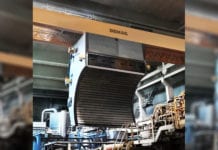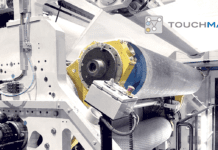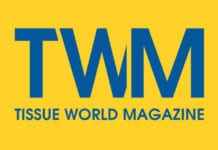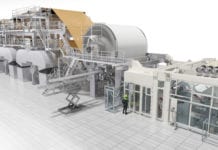(News from RISI) Although the Chinese tissue sector is in a state of oversupply and major mills are grabbing more market share, small players will not necessarily disappear, said Cao Zhenlei, Director of the China National Household Paper Industry Association (CNHPIA).
At a seminar held by the association and tissue producer Hebei Yihoucheng Commodity recently in Mancheng County, Hebei province, he said: “Due to the country’s vast territory, the Chinese market features a diversified structure, and small producers still have space to develop.”
Mancheng is home to some 100 small mills making around 700,000tpy of tissue, occupying one tenth of the national market.
Some leading regional firms there are investing in new PMs to enhance their position.
Hebei Yihoucheng is planning a second 25,000tpy tissue PM at a mill in Mancheng after a 25,000tpy Andritz unit came online in May.
The startup of the new machine is scheduled for next year.
Meanwhile, Baoding Gangxing Paper looks set to start up a Kawanoe Zoki machine with a capacity of 15,000tpy at its site in Mancheng.
And Hebei Xuesong Paper fired up a 25,000tpy unit supplied by the PMP Group earlier this year.
Seeking to upgrade: Mancheng’s increasing use of imported PMs can be ascribed to increasing awareness of quality and environmental factors.
Traditionally, plants there have run many small, domestically-made PMs, each unit having an annual capacity of several thousand tonnes of poor-quality tissue.
And the county’s tissue mills have long been blamed for causing serious pollution, in particular the Baiyangdian Lake incident in 2006.
The body of water, which is downstream from the tissue production hub, is the largest freshwater lake in the region.
A mass kill of fish and a dark greenish surface was reported in 2006, drawing national attention.
With environmental problems looming large in public discourse, the Chinese government has tightened pollution control measures.
Large scale obsolete capacity shutdown campaigns have been carried out for years across the country to encourage cleaner production.
Meanwhile, smog has been troubling the country, especially in the northern regions of Hebei province and Beijing.
This has forced the government to take strict measures to improve air quality.
Last winter, tissue mills in Mancheng were forced to suspend production due to heavy smog.
Moreover, local mills have been urged to rebuild their boilers to use gas instead of coal, which is thought to be the main source of the smog.
Hebei Yihoucheng was the first tissue mill in the county to use gas instead of coal to generate power.
The firm’s general manager Tian Yuwei admitted that the cost of gas is currently a little higher than that of coal. But in the long run, he believes that gas can help achieve sustainable development.
In April, China revised its environmental protection laws, with the revisions coming into effect January 1.
The new laws, believed to be the strictest on environmental protection in the country so far, will not only greatly reinforce protection measures, but also impose more severe punishments for any violations.
In the face of such pressure, the new PMs at Mancheng are believed to be a response, as they are more efficient and energy-saving than the old units, and can better meet the environmental standards in question.
Mancheng’s potential: The CNHPIA’s data showed the output of the four largest tissue firms in China last year accounted for 30.7% of total production in the country, and their sales volume accounted for around 35.4% of the industry’s total.
In 2010, the percentages were 22.6% for output and 27.9% for sales.
But most such output is from plants in China’s eastern and southern provinces. So far, there are no very big mills in northern China, which gives some room for Mancheng producers to develop.
What’s more, Mancheng is just 200 km from Beijing and Tianjin, which have a combined population of around 35 million; the proximity provides, according to the CNHPIA, great opportunities.
Thus, Cao stressed that rather than conduct pricing wars, Mancheng plants should focus more on quality and branding.
Tissue expansion: China’s tissue sector has seen rapid growth in recent years.
According to the CNHPIA, China’s tissue consumption and output in 2013 reached almost 6.04 million and 6.81 million tonnes respectively, up 7.2% and 8.5% over 2012.
The consumption of tissue per capita in China reached 4.4 kg in 2013, close to the world average consumption of 4.5 kg per capita.
In 2008, consumption was only 3.0 kg per capita in China.
The development has spurred an investment frenzy in the segment, with many new PMs firing up in the near term.
Hengan International will start up eight 60,000tpy tissue unit by 2015, raising its total capacity to almost 1.4 million tonnes/yr.
C&S Paper started up a 60,000tpy tissue PM at a greenfield site in Luoding city, Guangdong province, and a second, identical one is scheduled to come online there later this year.
Moreover, Guangxi Hwagain fired up a 60,000tpy tissue machine in March at a site in Ganzhou city, Jiangxi province.
Last year, that same mill started up a 60,000tpy tissue unit.
Meanwhile, new players are diversifying into the sector.
Sun Paper started up a 60,000tpy tissue PM in June at its flagship mill in Yanzhou city, Shandong province. A second one with the same capacity is expected to come on stream next year.
Zhejiang Jingxing Paper, a recycled containerboard producer, ordered a pair of 25,000tpy tissue units for a plant in Jiaxing city, Zhejiang province.
The first one is planned to kick off production later this year, followed by the second next year.






























